Comprehensive Analysis of the Economic Environment of Business
VerifiedAdded on 2023/06/10
|15
|3787
|375
Report
AI Summary
This report provides a detailed analysis of the economic environment impacting businesses, focusing on key concepts such as economies of scale and diseconomies of scale, illustrated with the example of British Airways. It explores the role of price mechanisms in a market economy and the effects of anti-competitive behavior, particularly in the context of Brexit and its impact on airlines like EasyJet. The report also examines price elasticity of demand for different types of flights and the implications for low-cost carriers. Furthermore, it assesses the impact of the Brexit vote on the value of the UK pound against the US dollar, explaining the factors contributing to its decline. Finally, the report discusses the importance of the European Union for businesses, highlighting its role in promoting trade, competition, and economic stability among member countries.
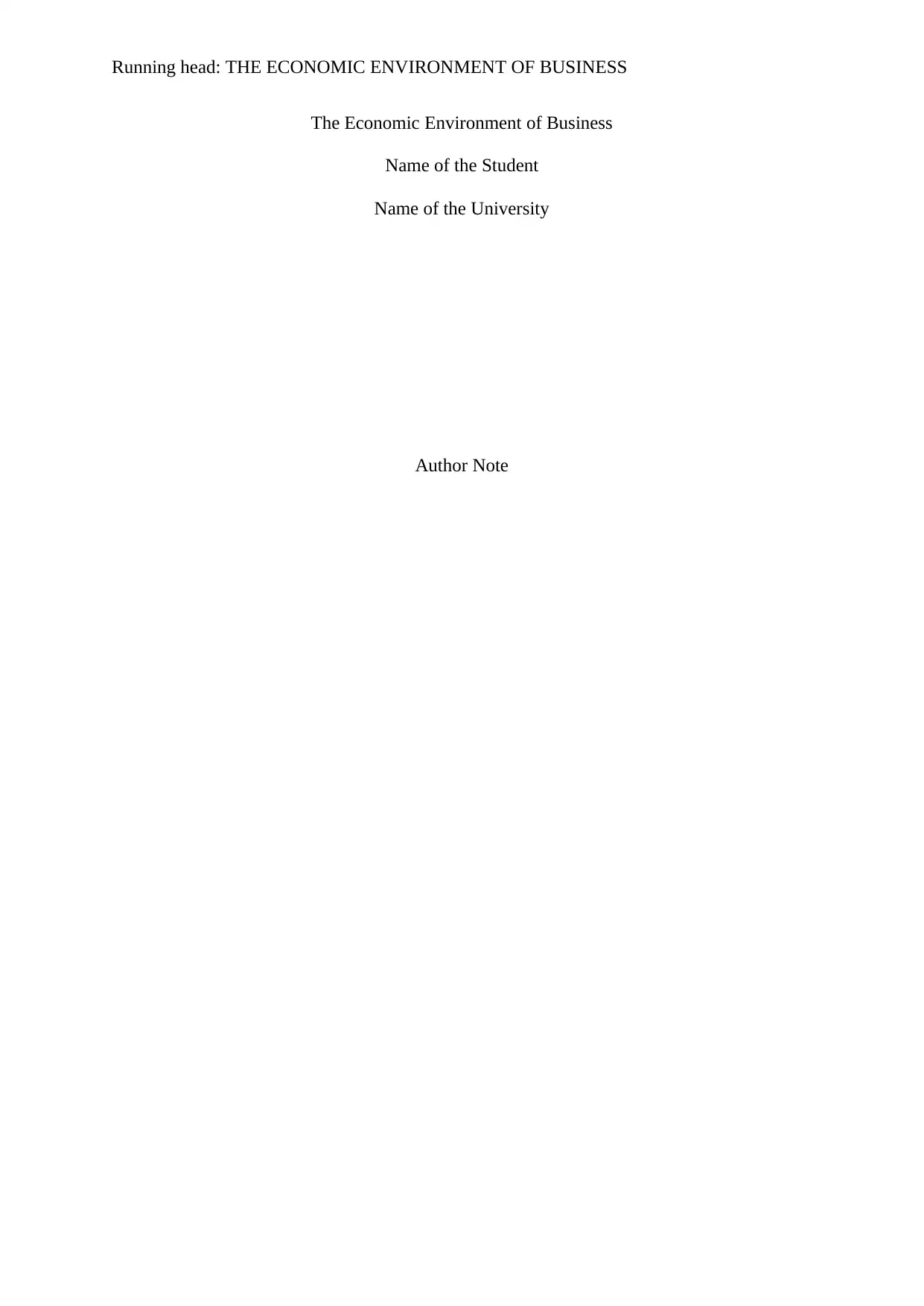
Running head: THE ECONOMIC ENVIRONMENT OF BUSINESS
The Economic Environment of Business
Name of the Student
Name of the University
Author Note
The Economic Environment of Business
Name of the Student
Name of the University
Author Note
Paraphrase This Document
Need a fresh take? Get an instant paraphrase of this document with our AI Paraphraser
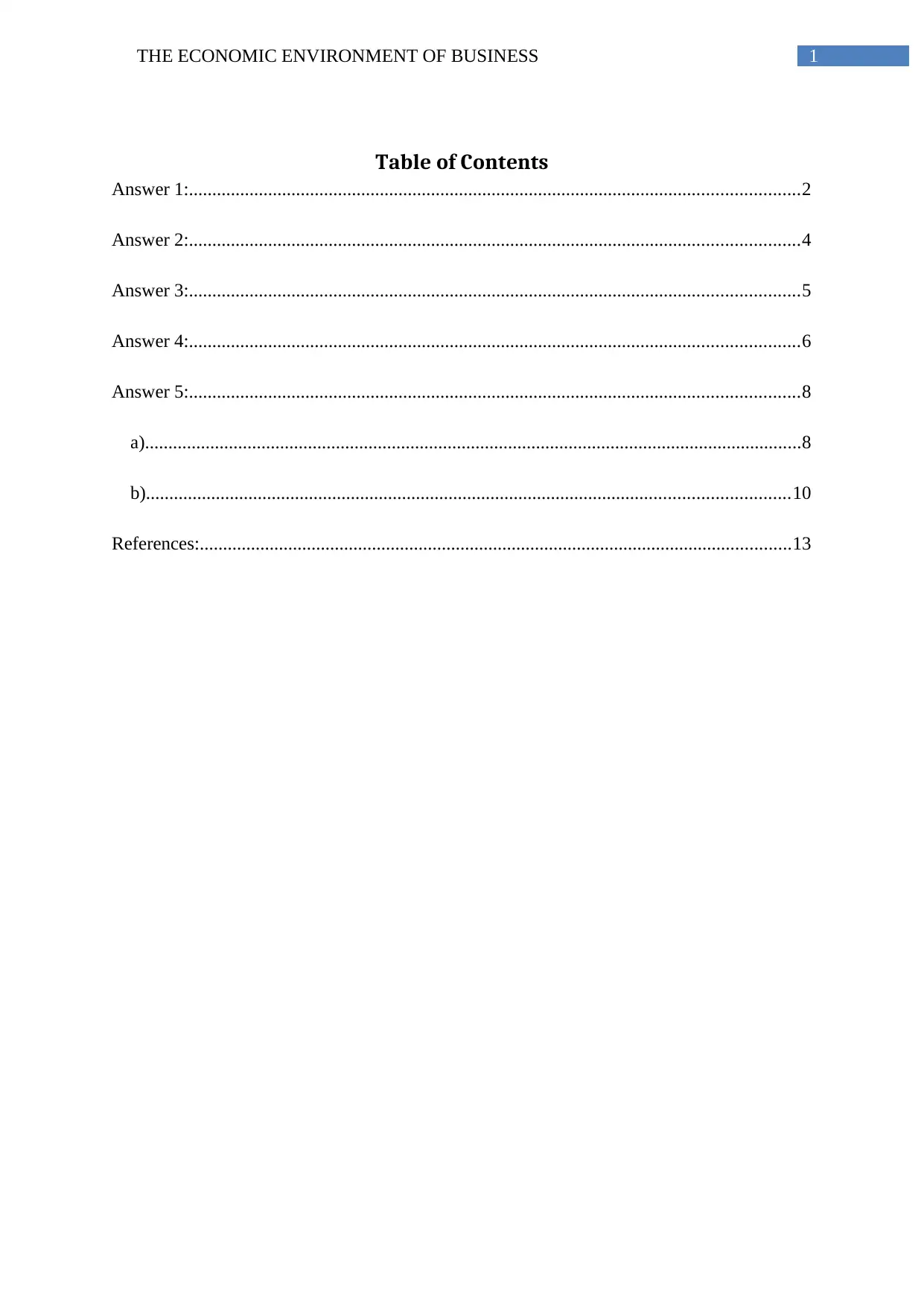
1THE ECONOMIC ENVIRONMENT OF BUSINESS
Table of Contents
Answer 1:...................................................................................................................................2
Answer 2:...................................................................................................................................4
Answer 3:...................................................................................................................................5
Answer 4:...................................................................................................................................6
Answer 5:...................................................................................................................................8
a).............................................................................................................................................8
b)..........................................................................................................................................10
References:...............................................................................................................................13
Table of Contents
Answer 1:...................................................................................................................................2
Answer 2:...................................................................................................................................4
Answer 3:...................................................................................................................................5
Answer 4:...................................................................................................................................6
Answer 5:...................................................................................................................................8
a).............................................................................................................................................8
b)..........................................................................................................................................10
References:...............................................................................................................................13
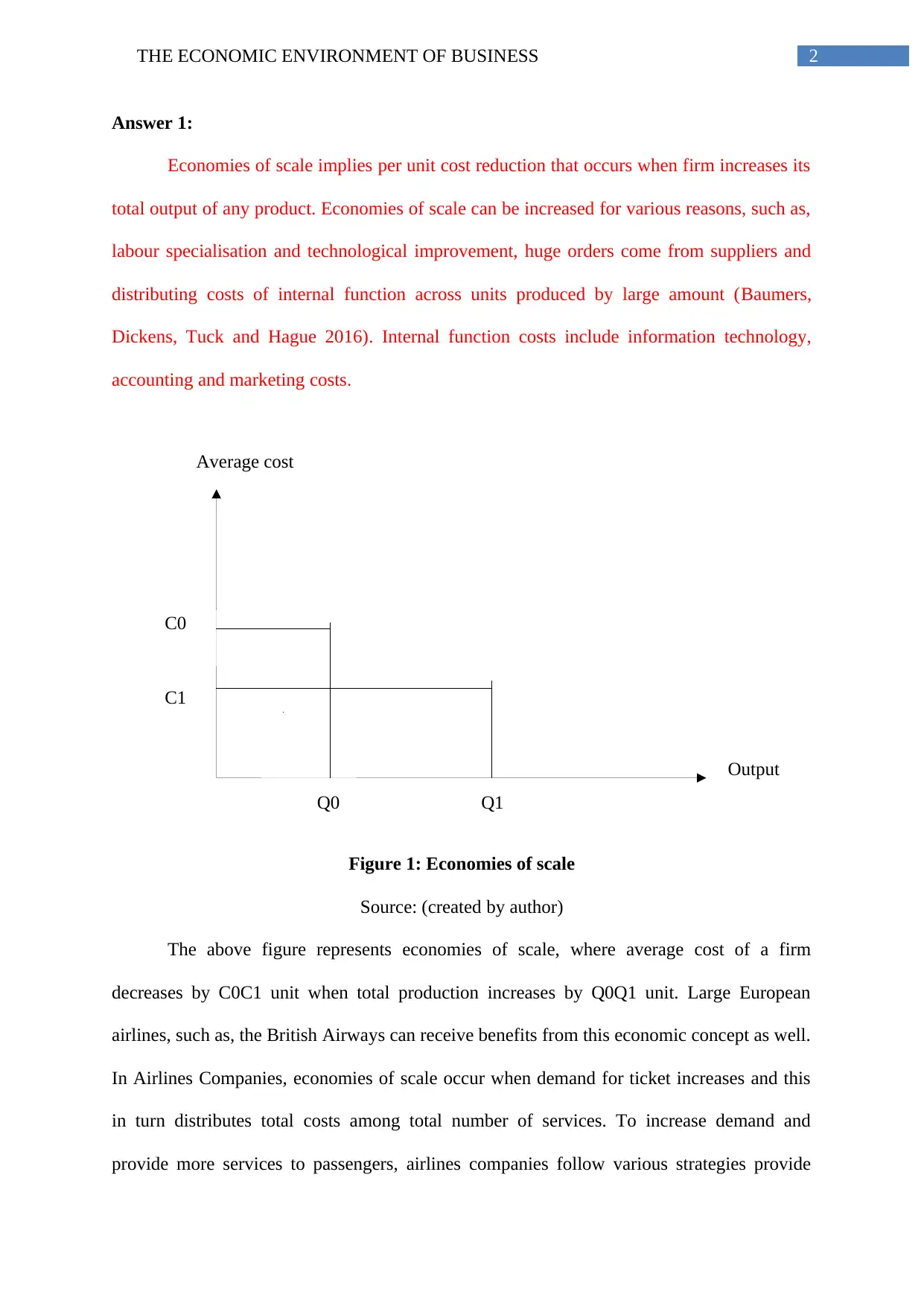
2THE ECONOMIC ENVIRONMENT OF BUSINESS
Average cost
Output
C0
C1
Q0 Q1
Answer 1:
Economies of scale implies per unit cost reduction that occurs when firm increases its
total output of any product. Economies of scale can be increased for various reasons, such as,
labour specialisation and technological improvement, huge orders come from suppliers and
distributing costs of internal function across units produced by large amount (Baumers,
Dickens, Tuck and Hague 2016). Internal function costs include information technology,
accounting and marketing costs.
Figure 1: Economies of scale
Source: (created by author)
The above figure represents economies of scale, where average cost of a firm
decreases by C0C1 unit when total production increases by Q0Q1 unit. Large European
airlines, such as, the British Airways can receive benefits from this economic concept as well.
In Airlines Companies, economies of scale occur when demand for ticket increases and this
in turn distributes total costs among total number of services. To increase demand and
provide more services to passengers, airlines companies follow various strategies provide
Average cost
Output
C0
C1
Q0 Q1
Answer 1:
Economies of scale implies per unit cost reduction that occurs when firm increases its
total output of any product. Economies of scale can be increased for various reasons, such as,
labour specialisation and technological improvement, huge orders come from suppliers and
distributing costs of internal function across units produced by large amount (Baumers,
Dickens, Tuck and Hague 2016). Internal function costs include information technology,
accounting and marketing costs.
Figure 1: Economies of scale
Source: (created by author)
The above figure represents economies of scale, where average cost of a firm
decreases by C0C1 unit when total production increases by Q0Q1 unit. Large European
airlines, such as, the British Airways can receive benefits from this economic concept as well.
In Airlines Companies, economies of scale occur when demand for ticket increases and this
in turn distributes total costs among total number of services. To increase demand and
provide more services to passengers, airlines companies follow various strategies provide
⊘ This is a preview!⊘
Do you want full access?
Subscribe today to unlock all pages.

Trusted by 1+ million students worldwide
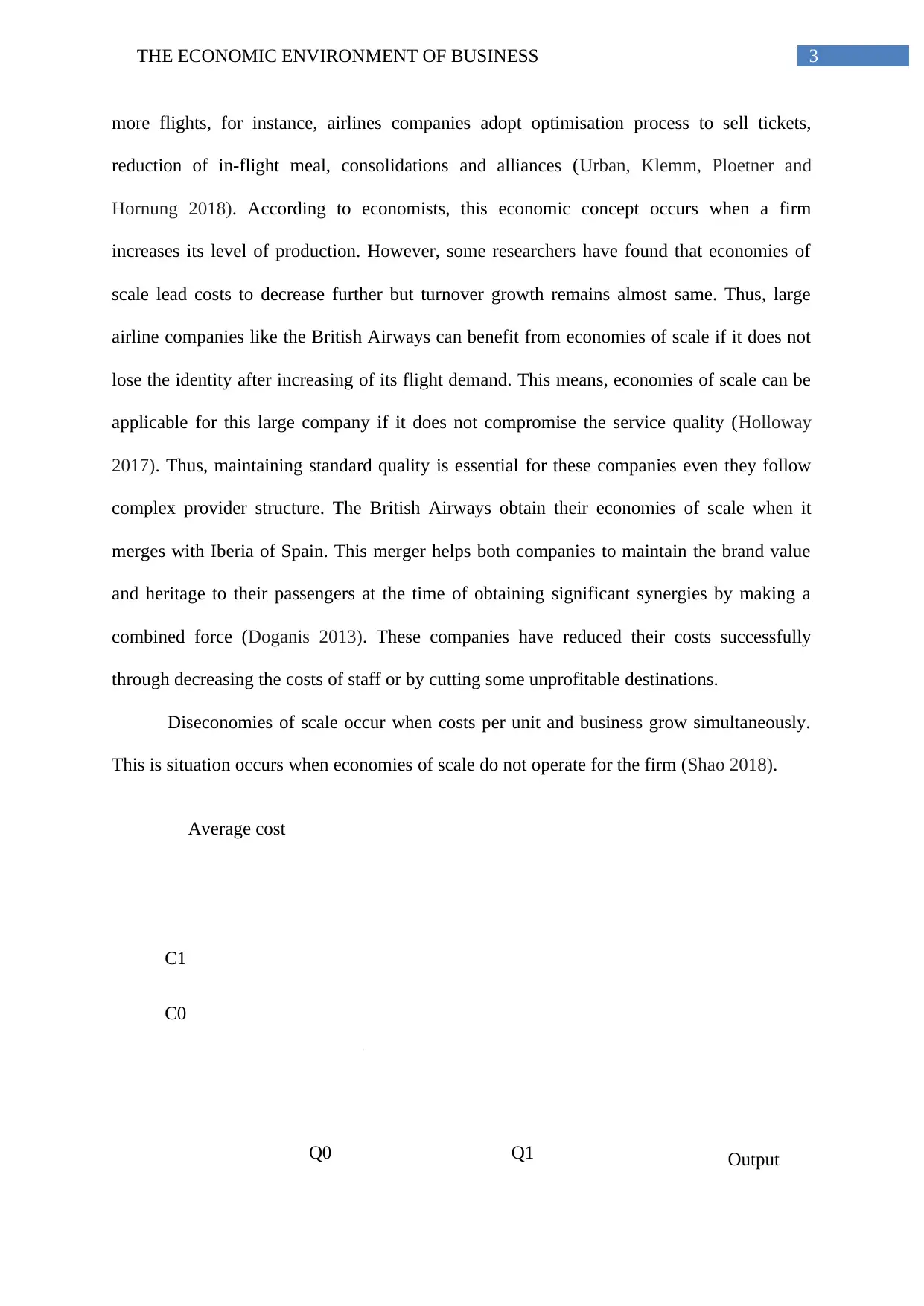
3THE ECONOMIC ENVIRONMENT OF BUSINESS
Average cost
Output
C0
C1
Q0 Q1
more flights, for instance, airlines companies adopt optimisation process to sell tickets,
reduction of in-flight meal, consolidations and alliances (Urban, Klemm, Ploetner and
Hornung 2018). According to economists, this economic concept occurs when a firm
increases its level of production. However, some researchers have found that economies of
scale lead costs to decrease further but turnover growth remains almost same. Thus, large
airline companies like the British Airways can benefit from economies of scale if it does not
lose the identity after increasing of its flight demand. This means, economies of scale can be
applicable for this large company if it does not compromise the service quality (Holloway
2017). Thus, maintaining standard quality is essential for these companies even they follow
complex provider structure. The British Airways obtain their economies of scale when it
merges with Iberia of Spain. This merger helps both companies to maintain the brand value
and heritage to their passengers at the time of obtaining significant synergies by making a
combined force (Doganis 2013). These companies have reduced their costs successfully
through decreasing the costs of staff or by cutting some unprofitable destinations.
Diseconomies of scale occur when costs per unit and business grow simultaneously.
This is situation occurs when economies of scale do not operate for the firm (Shao 2018).
Average cost
Output
C0
C1
Q0 Q1
more flights, for instance, airlines companies adopt optimisation process to sell tickets,
reduction of in-flight meal, consolidations and alliances (Urban, Klemm, Ploetner and
Hornung 2018). According to economists, this economic concept occurs when a firm
increases its level of production. However, some researchers have found that economies of
scale lead costs to decrease further but turnover growth remains almost same. Thus, large
airline companies like the British Airways can benefit from economies of scale if it does not
lose the identity after increasing of its flight demand. This means, economies of scale can be
applicable for this large company if it does not compromise the service quality (Holloway
2017). Thus, maintaining standard quality is essential for these companies even they follow
complex provider structure. The British Airways obtain their economies of scale when it
merges with Iberia of Spain. This merger helps both companies to maintain the brand value
and heritage to their passengers at the time of obtaining significant synergies by making a
combined force (Doganis 2013). These companies have reduced their costs successfully
through decreasing the costs of staff or by cutting some unprofitable destinations.
Diseconomies of scale occur when costs per unit and business grow simultaneously.
This is situation occurs when economies of scale do not operate for the firm (Shao 2018).
Paraphrase This Document
Need a fresh take? Get an instant paraphrase of this document with our AI Paraphraser
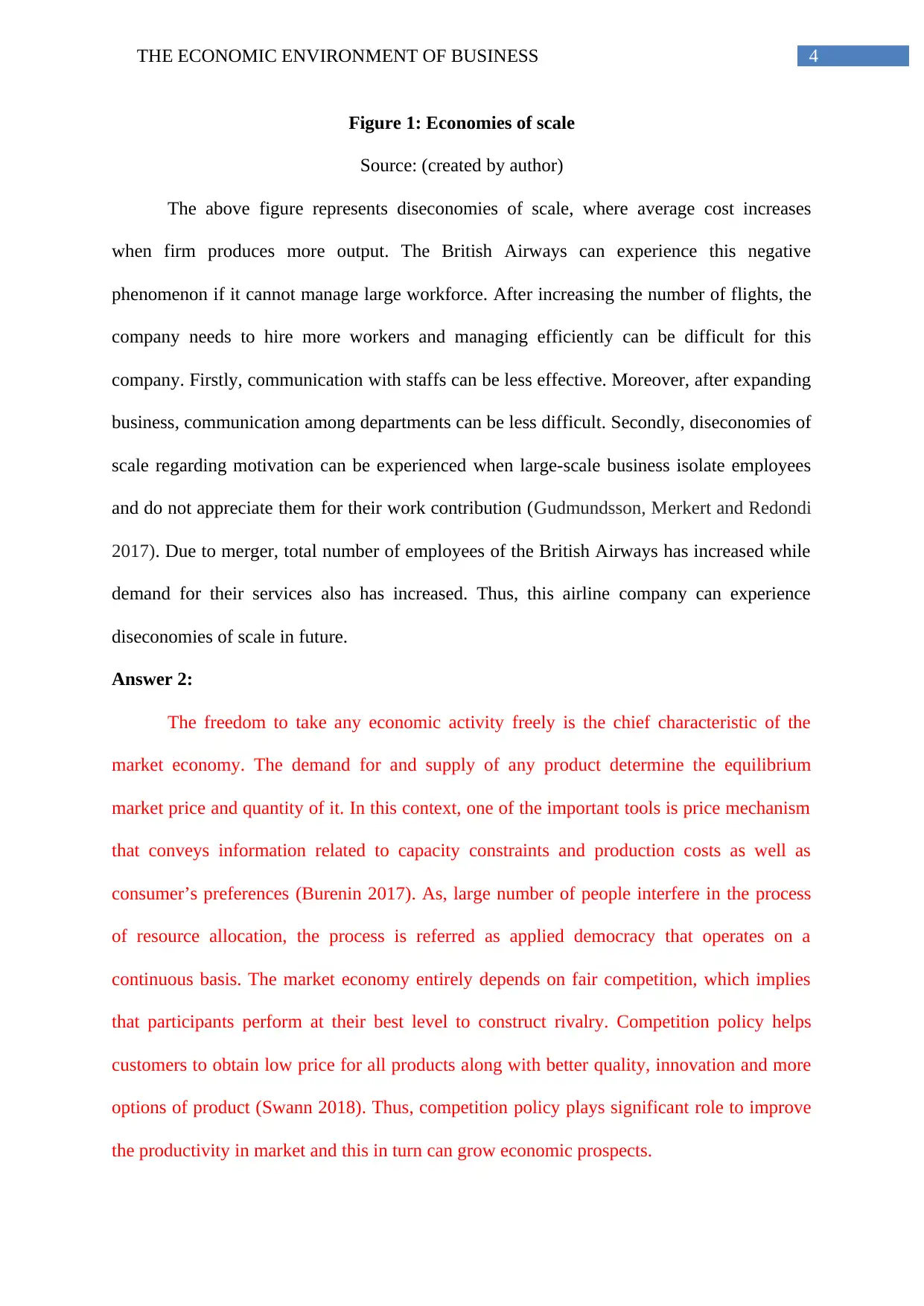
4THE ECONOMIC ENVIRONMENT OF BUSINESS
Figure 1: Economies of scale
Source: (created by author)
The above figure represents diseconomies of scale, where average cost increases
when firm produces more output. The British Airways can experience this negative
phenomenon if it cannot manage large workforce. After increasing the number of flights, the
company needs to hire more workers and managing efficiently can be difficult for this
company. Firstly, communication with staffs can be less effective. Moreover, after expanding
business, communication among departments can be less difficult. Secondly, diseconomies of
scale regarding motivation can be experienced when large-scale business isolate employees
and do not appreciate them for their work contribution (Gudmundsson, Merkert and Redondi
2017). Due to merger, total number of employees of the British Airways has increased while
demand for their services also has increased. Thus, this airline company can experience
diseconomies of scale in future.
Answer 2:
The freedom to take any economic activity freely is the chief characteristic of the
market economy. The demand for and supply of any product determine the equilibrium
market price and quantity of it. In this context, one of the important tools is price mechanism
that conveys information related to capacity constraints and production costs as well as
consumer’s preferences (Burenin 2017). As, large number of people interfere in the process
of resource allocation, the process is referred as applied democracy that operates on a
continuous basis. The market economy entirely depends on fair competition, which implies
that participants perform at their best level to construct rivalry. Competition policy helps
customers to obtain low price for all products along with better quality, innovation and more
options of product (Swann 2018). Thus, competition policy plays significant role to improve
the productivity in market and this in turn can grow economic prospects.
Figure 1: Economies of scale
Source: (created by author)
The above figure represents diseconomies of scale, where average cost increases
when firm produces more output. The British Airways can experience this negative
phenomenon if it cannot manage large workforce. After increasing the number of flights, the
company needs to hire more workers and managing efficiently can be difficult for this
company. Firstly, communication with staffs can be less effective. Moreover, after expanding
business, communication among departments can be less difficult. Secondly, diseconomies of
scale regarding motivation can be experienced when large-scale business isolate employees
and do not appreciate them for their work contribution (Gudmundsson, Merkert and Redondi
2017). Due to merger, total number of employees of the British Airways has increased while
demand for their services also has increased. Thus, this airline company can experience
diseconomies of scale in future.
Answer 2:
The freedom to take any economic activity freely is the chief characteristic of the
market economy. The demand for and supply of any product determine the equilibrium
market price and quantity of it. In this context, one of the important tools is price mechanism
that conveys information related to capacity constraints and production costs as well as
consumer’s preferences (Burenin 2017). As, large number of people interfere in the process
of resource allocation, the process is referred as applied democracy that operates on a
continuous basis. The market economy entirely depends on fair competition, which implies
that participants perform at their best level to construct rivalry. Competition policy helps
customers to obtain low price for all products along with better quality, innovation and more
options of product (Swann 2018). Thus, competition policy plays significant role to improve
the productivity in market and this in turn can grow economic prospects.
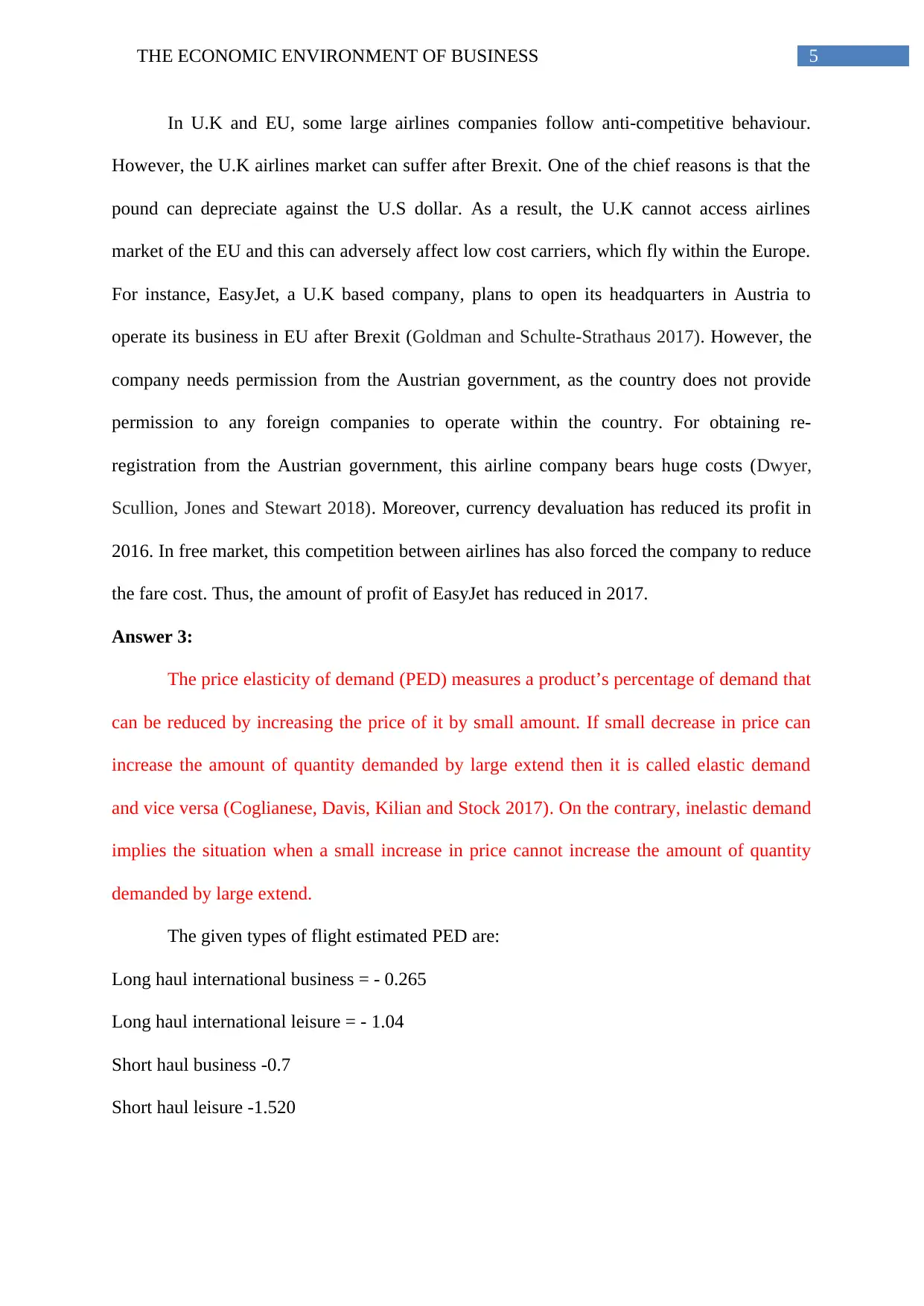
5THE ECONOMIC ENVIRONMENT OF BUSINESS
In U.K and EU, some large airlines companies follow anti-competitive behaviour.
However, the U.K airlines market can suffer after Brexit. One of the chief reasons is that the
pound can depreciate against the U.S dollar. As a result, the U.K cannot access airlines
market of the EU and this can adversely affect low cost carriers, which fly within the Europe.
For instance, EasyJet, a U.K based company, plans to open its headquarters in Austria to
operate its business in EU after Brexit (Goldman and Schulte-Strathaus 2017). However, the
company needs permission from the Austrian government, as the country does not provide
permission to any foreign companies to operate within the country. For obtaining re-
registration from the Austrian government, this airline company bears huge costs (Dwyer,
Scullion, Jones and Stewart 2018). Moreover, currency devaluation has reduced its profit in
2016. In free market, this competition between airlines has also forced the company to reduce
the fare cost. Thus, the amount of profit of EasyJet has reduced in 2017.
Answer 3:
The price elasticity of demand (PED) measures a product’s percentage of demand that
can be reduced by increasing the price of it by small amount. If small decrease in price can
increase the amount of quantity demanded by large extend then it is called elastic demand
and vice versa (Coglianese, Davis, Kilian and Stock 2017). On the contrary, inelastic demand
implies the situation when a small increase in price cannot increase the amount of quantity
demanded by large extend.
The given types of flight estimated PED are:
Long haul international business = - 0.265
Long haul international leisure = - 1.04
Short haul business -0.7
Short haul leisure -1.520
In U.K and EU, some large airlines companies follow anti-competitive behaviour.
However, the U.K airlines market can suffer after Brexit. One of the chief reasons is that the
pound can depreciate against the U.S dollar. As a result, the U.K cannot access airlines
market of the EU and this can adversely affect low cost carriers, which fly within the Europe.
For instance, EasyJet, a U.K based company, plans to open its headquarters in Austria to
operate its business in EU after Brexit (Goldman and Schulte-Strathaus 2017). However, the
company needs permission from the Austrian government, as the country does not provide
permission to any foreign companies to operate within the country. For obtaining re-
registration from the Austrian government, this airline company bears huge costs (Dwyer,
Scullion, Jones and Stewart 2018). Moreover, currency devaluation has reduced its profit in
2016. In free market, this competition between airlines has also forced the company to reduce
the fare cost. Thus, the amount of profit of EasyJet has reduced in 2017.
Answer 3:
The price elasticity of demand (PED) measures a product’s percentage of demand that
can be reduced by increasing the price of it by small amount. If small decrease in price can
increase the amount of quantity demanded by large extend then it is called elastic demand
and vice versa (Coglianese, Davis, Kilian and Stock 2017). On the contrary, inelastic demand
implies the situation when a small increase in price cannot increase the amount of quantity
demanded by large extend.
The given types of flight estimated PED are:
Long haul international business = - 0.265
Long haul international leisure = - 1.04
Short haul business -0.7
Short haul leisure -1.520
⊘ This is a preview!⊘
Do you want full access?
Subscribe today to unlock all pages.

Trusted by 1+ million students worldwide
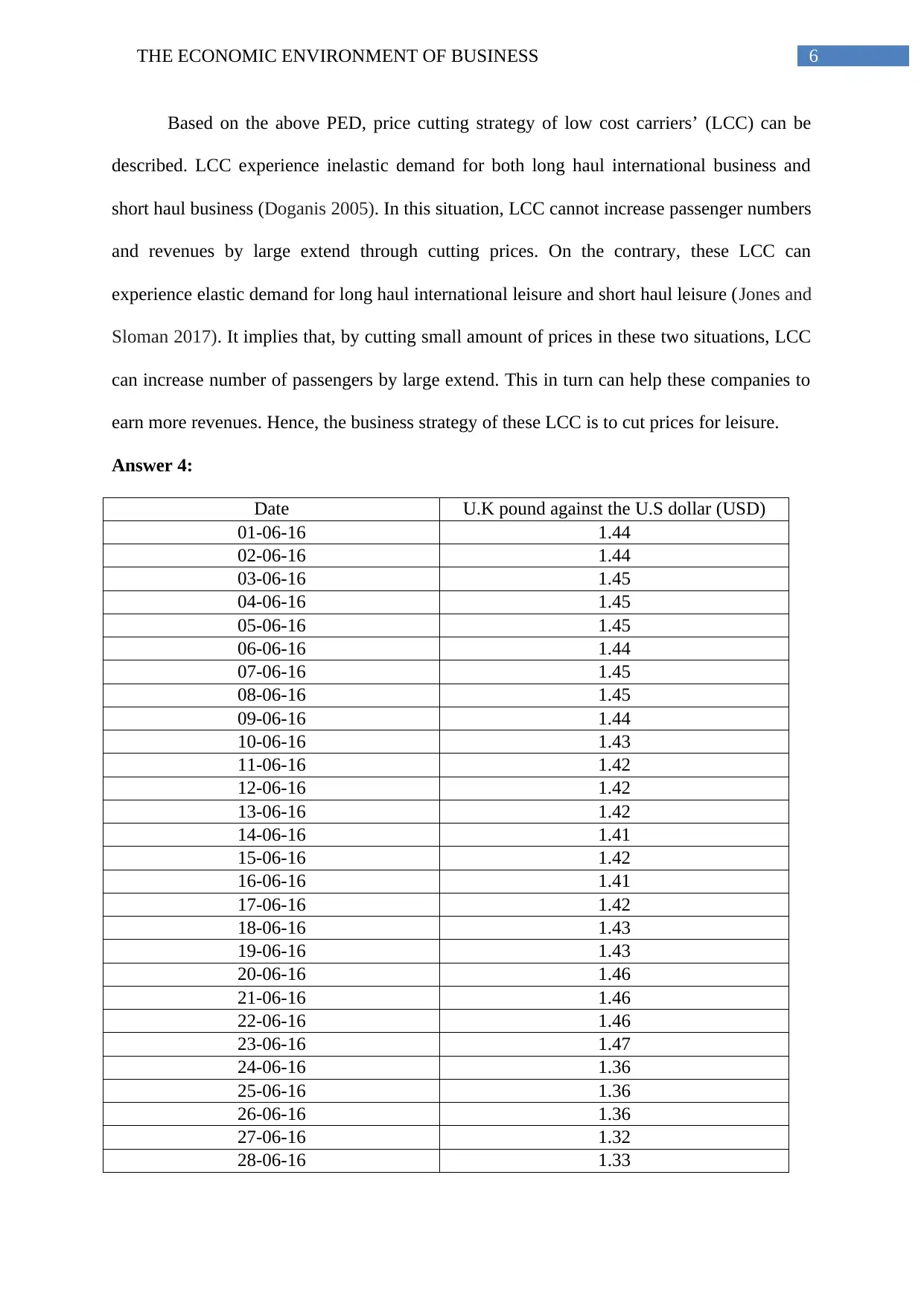
6THE ECONOMIC ENVIRONMENT OF BUSINESS
Based on the above PED, price cutting strategy of low cost carriers’ (LCC) can be
described. LCC experience inelastic demand for both long haul international business and
short haul business (Doganis 2005). In this situation, LCC cannot increase passenger numbers
and revenues by large extend through cutting prices. On the contrary, these LCC can
experience elastic demand for long haul international leisure and short haul leisure (Jones and
Sloman 2017). It implies that, by cutting small amount of prices in these two situations, LCC
can increase number of passengers by large extend. This in turn can help these companies to
earn more revenues. Hence, the business strategy of these LCC is to cut prices for leisure.
Answer 4:
Date U.K pound against the U.S dollar (USD)
01-06-16 1.44
02-06-16 1.44
03-06-16 1.45
04-06-16 1.45
05-06-16 1.45
06-06-16 1.44
07-06-16 1.45
08-06-16 1.45
09-06-16 1.44
10-06-16 1.43
11-06-16 1.42
12-06-16 1.42
13-06-16 1.42
14-06-16 1.41
15-06-16 1.42
16-06-16 1.41
17-06-16 1.42
18-06-16 1.43
19-06-16 1.43
20-06-16 1.46
21-06-16 1.46
22-06-16 1.46
23-06-16 1.47
24-06-16 1.36
25-06-16 1.36
26-06-16 1.36
27-06-16 1.32
28-06-16 1.33
Based on the above PED, price cutting strategy of low cost carriers’ (LCC) can be
described. LCC experience inelastic demand for both long haul international business and
short haul business (Doganis 2005). In this situation, LCC cannot increase passenger numbers
and revenues by large extend through cutting prices. On the contrary, these LCC can
experience elastic demand for long haul international leisure and short haul leisure (Jones and
Sloman 2017). It implies that, by cutting small amount of prices in these two situations, LCC
can increase number of passengers by large extend. This in turn can help these companies to
earn more revenues. Hence, the business strategy of these LCC is to cut prices for leisure.
Answer 4:
Date U.K pound against the U.S dollar (USD)
01-06-16 1.44
02-06-16 1.44
03-06-16 1.45
04-06-16 1.45
05-06-16 1.45
06-06-16 1.44
07-06-16 1.45
08-06-16 1.45
09-06-16 1.44
10-06-16 1.43
11-06-16 1.42
12-06-16 1.42
13-06-16 1.42
14-06-16 1.41
15-06-16 1.42
16-06-16 1.41
17-06-16 1.42
18-06-16 1.43
19-06-16 1.43
20-06-16 1.46
21-06-16 1.46
22-06-16 1.46
23-06-16 1.47
24-06-16 1.36
25-06-16 1.36
26-06-16 1.36
27-06-16 1.32
28-06-16 1.33
Paraphrase This Document
Need a fresh take? Get an instant paraphrase of this document with our AI Paraphraser
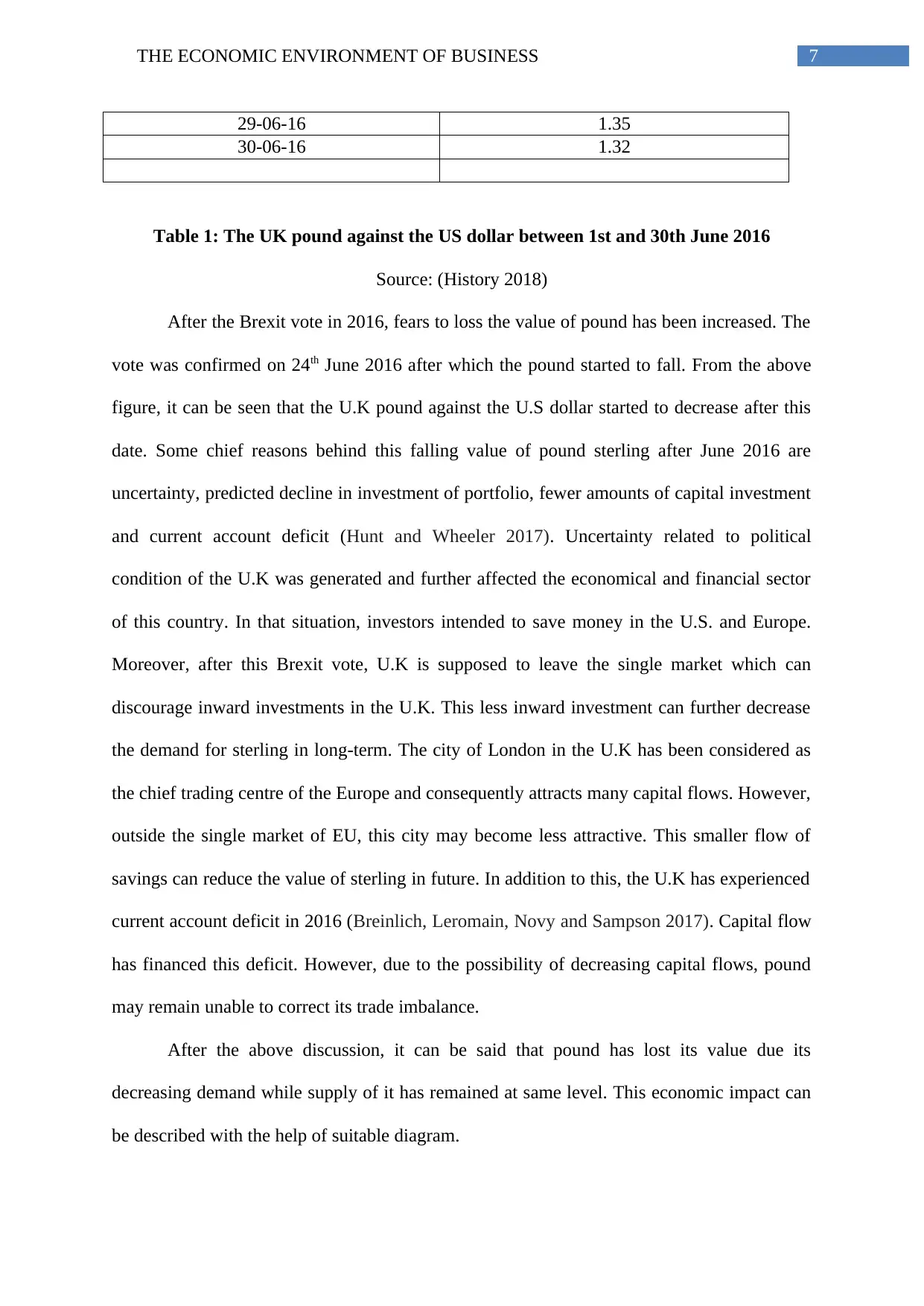
7THE ECONOMIC ENVIRONMENT OF BUSINESS
29-06-16 1.35
30-06-16 1.32
Table 1: The UK pound against the US dollar between 1st and 30th June 2016
Source: (History 2018)
After the Brexit vote in 2016, fears to loss the value of pound has been increased. The
vote was confirmed on 24th June 2016 after which the pound started to fall. From the above
figure, it can be seen that the U.K pound against the U.S dollar started to decrease after this
date. Some chief reasons behind this falling value of pound sterling after June 2016 are
uncertainty, predicted decline in investment of portfolio, fewer amounts of capital investment
and current account deficit (Hunt and Wheeler 2017). Uncertainty related to political
condition of the U.K was generated and further affected the economical and financial sector
of this country. In that situation, investors intended to save money in the U.S. and Europe.
Moreover, after this Brexit vote, U.K is supposed to leave the single market which can
discourage inward investments in the U.K. This less inward investment can further decrease
the demand for sterling in long-term. The city of London in the U.K has been considered as
the chief trading centre of the Europe and consequently attracts many capital flows. However,
outside the single market of EU, this city may become less attractive. This smaller flow of
savings can reduce the value of sterling in future. In addition to this, the U.K has experienced
current account deficit in 2016 (Breinlich, Leromain, Novy and Sampson 2017). Capital flow
has financed this deficit. However, due to the possibility of decreasing capital flows, pound
may remain unable to correct its trade imbalance.
After the above discussion, it can be said that pound has lost its value due its
decreasing demand while supply of it has remained at same level. This economic impact can
be described with the help of suitable diagram.
29-06-16 1.35
30-06-16 1.32
Table 1: The UK pound against the US dollar between 1st and 30th June 2016
Source: (History 2018)
After the Brexit vote in 2016, fears to loss the value of pound has been increased. The
vote was confirmed on 24th June 2016 after which the pound started to fall. From the above
figure, it can be seen that the U.K pound against the U.S dollar started to decrease after this
date. Some chief reasons behind this falling value of pound sterling after June 2016 are
uncertainty, predicted decline in investment of portfolio, fewer amounts of capital investment
and current account deficit (Hunt and Wheeler 2017). Uncertainty related to political
condition of the U.K was generated and further affected the economical and financial sector
of this country. In that situation, investors intended to save money in the U.S. and Europe.
Moreover, after this Brexit vote, U.K is supposed to leave the single market which can
discourage inward investments in the U.K. This less inward investment can further decrease
the demand for sterling in long-term. The city of London in the U.K has been considered as
the chief trading centre of the Europe and consequently attracts many capital flows. However,
outside the single market of EU, this city may become less attractive. This smaller flow of
savings can reduce the value of sterling in future. In addition to this, the U.K has experienced
current account deficit in 2016 (Breinlich, Leromain, Novy and Sampson 2017). Capital flow
has financed this deficit. However, due to the possibility of decreasing capital flows, pound
may remain unable to correct its trade imbalance.
After the above discussion, it can be said that pound has lost its value due its
decreasing demand while supply of it has remained at same level. This economic impact can
be described with the help of suitable diagram.
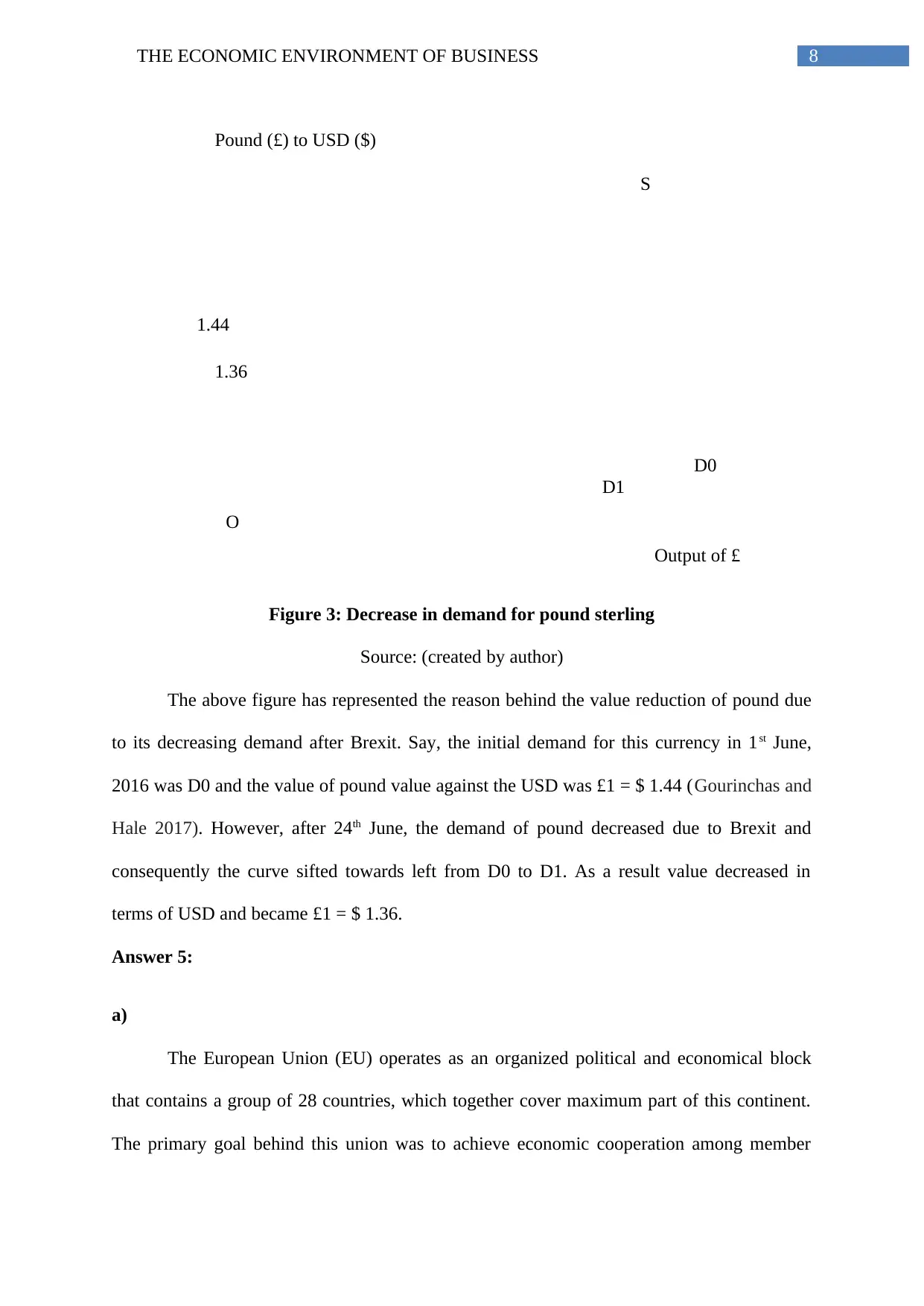
8THE ECONOMIC ENVIRONMENT OF BUSINESS
Pound (£) to USD ($)
S
D0
D1
Output of £
1.44
1.36
O
Figure 3: Decrease in demand for pound sterling
Source: (created by author)
The above figure has represented the reason behind the value reduction of pound due
to its decreasing demand after Brexit. Say, the initial demand for this currency in 1st June,
2016 was D0 and the value of pound value against the USD was £1 = $ 1.44 (Gourinchas and
Hale 2017). However, after 24th June, the demand of pound decreased due to Brexit and
consequently the curve sifted towards left from D0 to D1. As a result value decreased in
terms of USD and became £1 = $ 1.36.
Answer 5:
a)
The European Union (EU) operates as an organized political and economical block
that contains a group of 28 countries, which together cover maximum part of this continent.
The primary goal behind this union was to achieve economic cooperation among member
Pound (£) to USD ($)
S
D0
D1
Output of £
1.44
1.36
O
Figure 3: Decrease in demand for pound sterling
Source: (created by author)
The above figure has represented the reason behind the value reduction of pound due
to its decreasing demand after Brexit. Say, the initial demand for this currency in 1st June,
2016 was D0 and the value of pound value against the USD was £1 = $ 1.44 (Gourinchas and
Hale 2017). However, after 24th June, the demand of pound decreased due to Brexit and
consequently the curve sifted towards left from D0 to D1. As a result value decreased in
terms of USD and became £1 = $ 1.36.
Answer 5:
a)
The European Union (EU) operates as an organized political and economical block
that contains a group of 28 countries, which together cover maximum part of this continent.
The primary goal behind this union was to achieve economic cooperation among member
⊘ This is a preview!⊘
Do you want full access?
Subscribe today to unlock all pages.

Trusted by 1+ million students worldwide
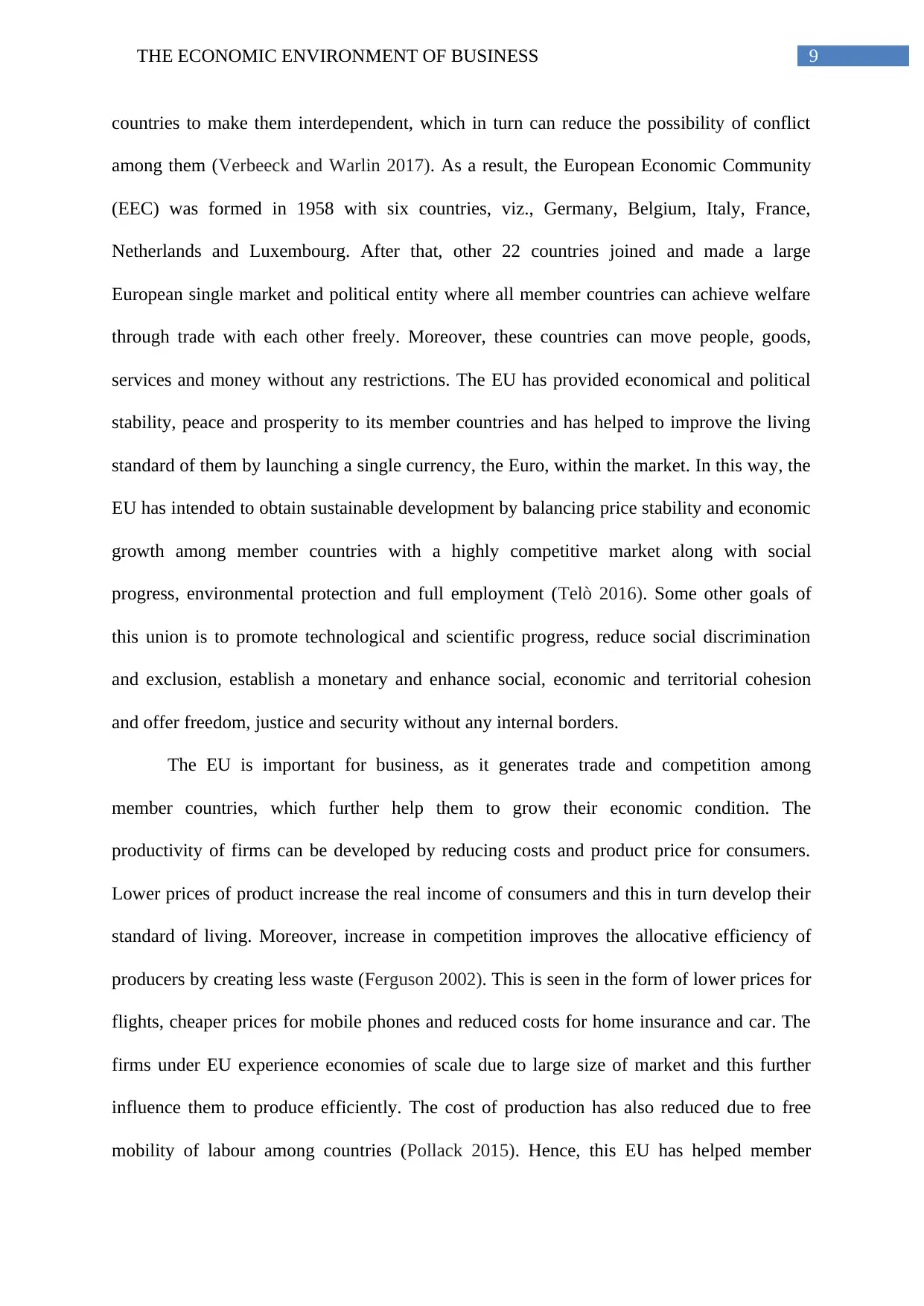
9THE ECONOMIC ENVIRONMENT OF BUSINESS
countries to make them interdependent, which in turn can reduce the possibility of conflict
among them (Verbeeck and Warlin 2017). As a result, the European Economic Community
(EEC) was formed in 1958 with six countries, viz., Germany, Belgium, Italy, France,
Netherlands and Luxembourg. After that, other 22 countries joined and made a large
European single market and political entity where all member countries can achieve welfare
through trade with each other freely. Moreover, these countries can move people, goods,
services and money without any restrictions. The EU has provided economical and political
stability, peace and prosperity to its member countries and has helped to improve the living
standard of them by launching a single currency, the Euro, within the market. In this way, the
EU has intended to obtain sustainable development by balancing price stability and economic
growth among member countries with a highly competitive market along with social
progress, environmental protection and full employment (Telò 2016). Some other goals of
this union is to promote technological and scientific progress, reduce social discrimination
and exclusion, establish a monetary and enhance social, economic and territorial cohesion
and offer freedom, justice and security without any internal borders.
The EU is important for business, as it generates trade and competition among
member countries, which further help them to grow their economic condition. The
productivity of firms can be developed by reducing costs and product price for consumers.
Lower prices of product increase the real income of consumers and this in turn develop their
standard of living. Moreover, increase in competition improves the allocative efficiency of
producers by creating less waste (Ferguson 2002). This is seen in the form of lower prices for
flights, cheaper prices for mobile phones and reduced costs for home insurance and car. The
firms under EU experience economies of scale due to large size of market and this further
influence them to produce efficiently. The cost of production has also reduced due to free
mobility of labour among countries (Pollack 2015). Hence, this EU has helped member
countries to make them interdependent, which in turn can reduce the possibility of conflict
among them (Verbeeck and Warlin 2017). As a result, the European Economic Community
(EEC) was formed in 1958 with six countries, viz., Germany, Belgium, Italy, France,
Netherlands and Luxembourg. After that, other 22 countries joined and made a large
European single market and political entity where all member countries can achieve welfare
through trade with each other freely. Moreover, these countries can move people, goods,
services and money without any restrictions. The EU has provided economical and political
stability, peace and prosperity to its member countries and has helped to improve the living
standard of them by launching a single currency, the Euro, within the market. In this way, the
EU has intended to obtain sustainable development by balancing price stability and economic
growth among member countries with a highly competitive market along with social
progress, environmental protection and full employment (Telò 2016). Some other goals of
this union is to promote technological and scientific progress, reduce social discrimination
and exclusion, establish a monetary and enhance social, economic and territorial cohesion
and offer freedom, justice and security without any internal borders.
The EU is important for business, as it generates trade and competition among
member countries, which further help them to grow their economic condition. The
productivity of firms can be developed by reducing costs and product price for consumers.
Lower prices of product increase the real income of consumers and this in turn develop their
standard of living. Moreover, increase in competition improves the allocative efficiency of
producers by creating less waste (Ferguson 2002). This is seen in the form of lower prices for
flights, cheaper prices for mobile phones and reduced costs for home insurance and car. The
firms under EU experience economies of scale due to large size of market and this further
influence them to produce efficiently. The cost of production has also reduced due to free
mobility of labour among countries (Pollack 2015). Hence, this EU has helped member
Paraphrase This Document
Need a fresh take? Get an instant paraphrase of this document with our AI Paraphraser
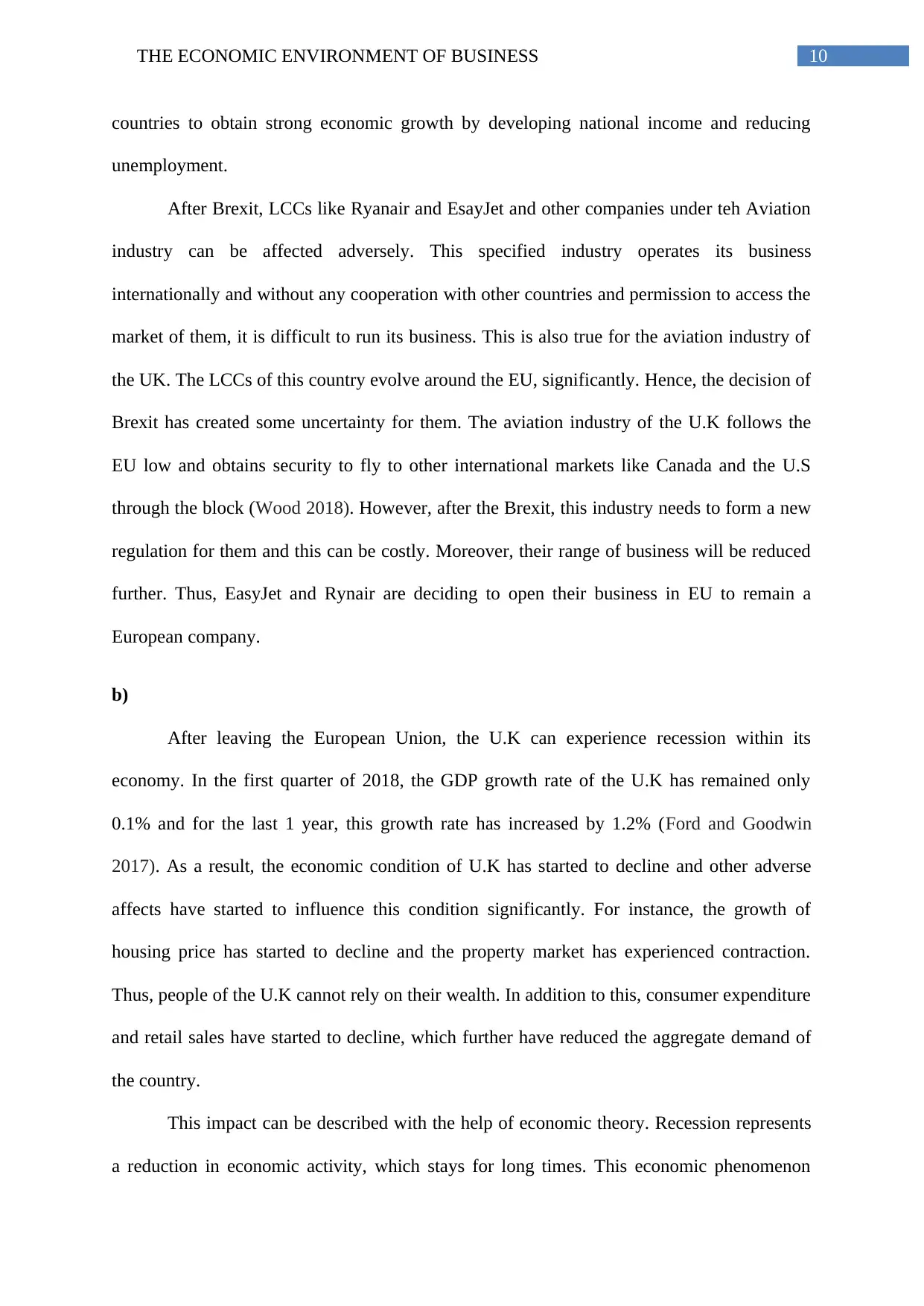
10THE ECONOMIC ENVIRONMENT OF BUSINESS
countries to obtain strong economic growth by developing national income and reducing
unemployment.
After Brexit, LCCs like Ryanair and EsayJet and other companies under teh Aviation
industry can be affected adversely. This specified industry operates its business
internationally and without any cooperation with other countries and permission to access the
market of them, it is difficult to run its business. This is also true for the aviation industry of
the UK. The LCCs of this country evolve around the EU, significantly. Hence, the decision of
Brexit has created some uncertainty for them. The aviation industry of the U.K follows the
EU low and obtains security to fly to other international markets like Canada and the U.S
through the block (Wood 2018). However, after the Brexit, this industry needs to form a new
regulation for them and this can be costly. Moreover, their range of business will be reduced
further. Thus, EasyJet and Rynair are deciding to open their business in EU to remain a
European company.
b)
After leaving the European Union, the U.K can experience recession within its
economy. In the first quarter of 2018, the GDP growth rate of the U.K has remained only
0.1% and for the last 1 year, this growth rate has increased by 1.2% (Ford and Goodwin
2017). As a result, the economic condition of U.K has started to decline and other adverse
affects have started to influence this condition significantly. For instance, the growth of
housing price has started to decline and the property market has experienced contraction.
Thus, people of the U.K cannot rely on their wealth. In addition to this, consumer expenditure
and retail sales have started to decline, which further have reduced the aggregate demand of
the country.
This impact can be described with the help of economic theory. Recession represents
a reduction in economic activity, which stays for long times. This economic phenomenon
countries to obtain strong economic growth by developing national income and reducing
unemployment.
After Brexit, LCCs like Ryanair and EsayJet and other companies under teh Aviation
industry can be affected adversely. This specified industry operates its business
internationally and without any cooperation with other countries and permission to access the
market of them, it is difficult to run its business. This is also true for the aviation industry of
the UK. The LCCs of this country evolve around the EU, significantly. Hence, the decision of
Brexit has created some uncertainty for them. The aviation industry of the U.K follows the
EU low and obtains security to fly to other international markets like Canada and the U.S
through the block (Wood 2018). However, after the Brexit, this industry needs to form a new
regulation for them and this can be costly. Moreover, their range of business will be reduced
further. Thus, EasyJet and Rynair are deciding to open their business in EU to remain a
European company.
b)
After leaving the European Union, the U.K can experience recession within its
economy. In the first quarter of 2018, the GDP growth rate of the U.K has remained only
0.1% and for the last 1 year, this growth rate has increased by 1.2% (Ford and Goodwin
2017). As a result, the economic condition of U.K has started to decline and other adverse
affects have started to influence this condition significantly. For instance, the growth of
housing price has started to decline and the property market has experienced contraction.
Thus, people of the U.K cannot rely on their wealth. In addition to this, consumer expenditure
and retail sales have started to decline, which further have reduced the aggregate demand of
the country.
This impact can be described with the help of economic theory. Recession represents
a reduction in economic activity, which stays for long times. This economic phenomenon
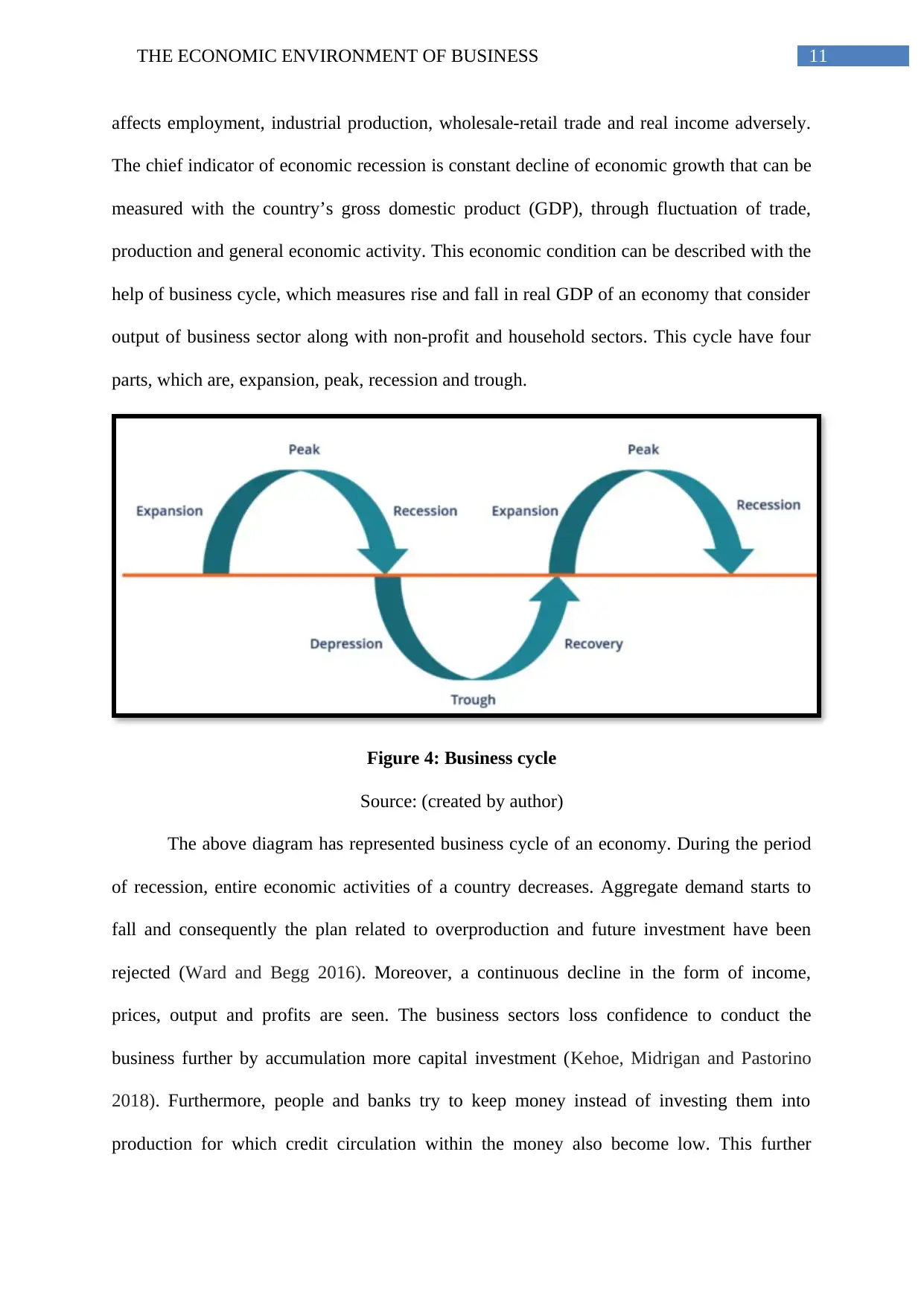
11THE ECONOMIC ENVIRONMENT OF BUSINESS
affects employment, industrial production, wholesale-retail trade and real income adversely.
The chief indicator of economic recession is constant decline of economic growth that can be
measured with the country’s gross domestic product (GDP), through fluctuation of trade,
production and general economic activity. This economic condition can be described with the
help of business cycle, which measures rise and fall in real GDP of an economy that consider
output of business sector along with non-profit and household sectors. This cycle have four
parts, which are, expansion, peak, recession and trough.
Figure 4: Business cycle
Source: (created by author)
The above diagram has represented business cycle of an economy. During the period
of recession, entire economic activities of a country decreases. Aggregate demand starts to
fall and consequently the plan related to overproduction and future investment have been
rejected (Ward and Begg 2016). Moreover, a continuous decline in the form of income,
prices, output and profits are seen. The business sectors loss confidence to conduct the
business further by accumulation more capital investment (Kehoe, Midrigan and Pastorino
2018). Furthermore, people and banks try to keep money instead of investing them into
production for which credit circulation within the money also become low. This further
affects employment, industrial production, wholesale-retail trade and real income adversely.
The chief indicator of economic recession is constant decline of economic growth that can be
measured with the country’s gross domestic product (GDP), through fluctuation of trade,
production and general economic activity. This economic condition can be described with the
help of business cycle, which measures rise and fall in real GDP of an economy that consider
output of business sector along with non-profit and household sectors. This cycle have four
parts, which are, expansion, peak, recession and trough.
Figure 4: Business cycle
Source: (created by author)
The above diagram has represented business cycle of an economy. During the period
of recession, entire economic activities of a country decreases. Aggregate demand starts to
fall and consequently the plan related to overproduction and future investment have been
rejected (Ward and Begg 2016). Moreover, a continuous decline in the form of income,
prices, output and profits are seen. The business sectors loss confidence to conduct the
business further by accumulation more capital investment (Kehoe, Midrigan and Pastorino
2018). Furthermore, people and banks try to keep money instead of investing them into
production for which credit circulation within the money also become low. This further
⊘ This is a preview!⊘
Do you want full access?
Subscribe today to unlock all pages.

Trusted by 1+ million students worldwide
1 out of 15
Related Documents
Your All-in-One AI-Powered Toolkit for Academic Success.
+13062052269
info@desklib.com
Available 24*7 on WhatsApp / Email
![[object Object]](/_next/static/media/star-bottom.7253800d.svg)
Unlock your academic potential
Copyright © 2020–2025 A2Z Services. All Rights Reserved. Developed and managed by ZUCOL.




